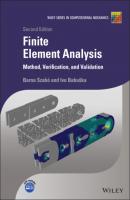Finite Element Analysis. Barna Szabó
Чтение книги онлайн.

Читать онлайн книгу Finite Element Analysis - Barna Szabó страница 19
Название: Finite Element Analysis
Автор: Barna Szabó
Издательство: John Wiley & Sons Limited
Жанр: Физика
isbn: 9781119426462
isbn:
where unless
. Therefore any admissible nonzero perturbation of u will increase
.
This important theorem, called the theorem or principle of minimum potential energy, will be used in Chapter 7 as our starting point in the formulation of mathematical models for beams, plates and shells.
Given the potential energy and the space of admissible functions, it is possible to determine the strong form. This is illustrated by the following example.
Example 1.2 Let us determine the strong form corresponding to the potential energy defined by
with .
Since u minimizes , any perturbation of u by
will increase
. Therefore
is minimum at
and hence
(1.39)
Therefore we have
where the last two terms are zero because . Integrating the first term by parts,
and, substituting this into eq. (1.40), we get
(1.41)
Since this holds for all , the bracketed expression must be zero. In other words, the solution of the differential equation
(1.42)
minimizes the potential energy defined by eq. (1.38). This is the strong form of the problem.
Remark 1.2 The procedure in Example 1.2 is used in the calculus of variations for identifying the differential equation, known as the Euler9‐Lagrange10 equation, the solution of which maximizes or minimizes a functional. In this example the solution minimizes the potential energy on the space .
Remark 1.3 Whereas the strain energy is always positive, the potential energy may be positive, negative or zero.
1.3 Approximate solutions
The trial and test spaces defined in the preceding section are infinite‐dimensional, that is, they span infinitely many linearly independent functions. To find an approximate solution, we construct finite‐dimensional subspaces denoted, respectively, by СКАЧАТЬ